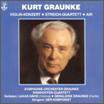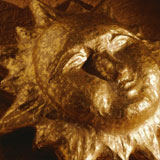|
Kurt Graunke: Streichquartett / String Quartet:
1. Satz: Adagio – Allegro non troppo 10'40'', 2. Satz: Adagio 7'58'', 3. Satz: Scherzando 4'43'', 4. Satz: Allegro giocoso 4'00''.
Sinnhoffer-Quartett.
Hörprobe: Streichquartett, 3. Satz: 112streichquartett3satz45.mp3 [715 KB]
Im Oktober 1974 entstand in München, dem Wohn- und Schaffensort Graunkes, sein Streichquartett, das am 27. Januar 1975 vom Sinnhoffer-Quartett uraufgeführt wurde. Das in der Grundhaltung oft erregte, sich steigernde Werk ist ganz gewiss keine "Kapellmeistermusik". Traditionell ist die Viersätzigkeit, ist der regelmäßige Bau mit Durchführung und Reprise, klassisch-romantischen Vorbildern folgend. Reger wird gewissermaßen in die Gegenwart hin erweitert, Erfahrungen mit Bartók und Strawinsky werden eingebracht. Aus dem dichten, interessant geführten, polyphonen, aber selten kontrapunktischen Satz spricht der Streicher, aus der Klangfülle – bis zur Achtstimmigkeit im Finale – der Symphoniker. Die Tonalität ist latent spürbar, aber entrückt, die Funktionsharmonik verschleiert. Über eine knappe halbe Stunde spannt sich der Bogen von der langsamen Einleitung zum ersten Satz – auch das eine Vorwegnahme symphonischer Gestaltung – bis zur Stretta, die den knappen Finalsatz beschließt. Einer Streichorchester-Fassung, die schon formale Erweiterungen mit sich brachte, folgte dann 1976 die Umarbeitung zur Symphonie – zur dritten im Oeuvre des Komponisten Kurt Graunke.
In October of 1974 the string quartet was composed in Munich, Graunke's place of domicile and locus of creation. Its premiere of January 27, 1975 was given by the Sinnhoffer Quartet. The work, with its often urgent and aroused character, its tendency to seek higher and higher climaxes, is certainly no tame "Kapellmeistermusik". Traditional are the four movements, the regular construction with development section and recapitulation. The quartet follows classic-romantic models. Reger is – so to speak – amplified into the present: the experience of Bartók and Stravinsky leaves its mark. From out of the dense, polyphonal, complexly developed but only seldom contrapuntal music ones hears the strings of a full symphony orchestra: a rich and opulent sound. And in the fact the string quartet builds up to eight separate voices in the Finale! The tonality is felt, latent, but at great distance; the harmonies veil more than they reveal. The quartet lasts a good half hour, from the slow introduction of the first movement – this too an anticipation of symphonic form – to the stretta which concludes the terse last movement. The quartet was followed by a version for string orchestra which led to certain formal modifications and extensions. In 1976 came the full reworking as a symphony – the third in Kurt Graunke's symphonic oeuvre.
Darüberhinaus enthält diese CD:
Kurt Graunke: Violinkonzert / Violin Concerto:
1. Satz: Allegro moderato 12'46'', 2. Satz: Passacaglia (Adagio) 5'35'', 3. Satz: Rondo (Allegro giocoso) 6'54''.
Solist / soloist: Lukas David (Violine), Symphonie-Orchester Graunke, Dirigent / conductor: Kurt Graunke.
Hörprobe: Violinkonzert, 1. Satz: 112violinkonzert1satz45.mp3 [739 KB]
Der Komponist Kurt Graunke war – er kann es nicht verleugnen – von Haus aus Geiger. So ist es nicht verwunderlich, dass sein erstes großes und zu allgemeinem Ansehen gelangtes Werk ein Violinkonzert war. Der Solopart fiel dementsprechend anspruchsvoll aus. Über ruhigem Orchester-Background, aus dem charakteristische Pauken-Akzente herausklingen, schwingt zunächst eine große Geigen-Kantilene, bis ein virtuoser Übergang zum wieder sanghaften zweiten Thema führt. Im weiteren Verlauf des sehr ausgedehnten ersten Satzes – er ist so lang wie die anderen beiden zusammen – fällt die starke Rolle der Bläser auf, die sie im Orchester zu spielen haben. Klangliche Opulenz, die eine gewisse Süße nicht ausschließt, unterscheidet das Werk stellenweise auch stilistisch von den (späteren) Symphonie. Der zweite Satz, eine Passacaglia, ist streng gebaut – allerdings über einem fünftaktigen Thema; Graunke liebt solche Unregelmäßigkeiten. Beginn und Ausklang gleichen sich, das Thema liegt allein in den Bässen. Graunke bekennt sich – nicht nur darin, überhaupt als Orchesterleiter und oft auch als Komponist – zu Max Reger, der im tänzerischen Rondo-Finale nicht mehr zu überhören ist; natürlich auch in der Fuge, die aus dem Material herauswächst, und im Schluss, der bis zum endgültigen E(-dur) ungewiss bleibt.
The composer Kurt Graunke – he would never wish to deny it – is a violinist to his bones. And so it is not surprising that his first large and critically acclaimed work should be a violin concerto. The solo part is correspondingly ambitious. Over a quiet orchestral background, from which characteristic timpani accents can be heard, a grand violin cantilena arches up and then, in a virtuosic outburst, makes the transition to another song-like second theme. In the further course of the extremely extended first movement – it is as long as the other two movements together – the important role of the winds in the orchestra is remarkable. A tonal opulence, not without sweetness, distinguishes the work at times stylistically from the (later composed) symphonies.
The second movement, a Passacaglia, is strict in its form, based however on a five-measure theme: Graunke is a lover of such irregularities. The beginning and the end of the movement resemble each other: the theme is in the basses alone. Graunke holds with Max Reger – not only in this point but as conductor and at times also as composer. And so Reger's mark is felt unmistakably in the dancy Rondo-Finale, also of course in the fugue, which grows up naturally out of the materials, and in the conclusion of the concerto whose key remains uncertain up to the ultimate E major.
Kurt Graunke: Air (Fassung für Solo-Harfe und Orchester / Version for solo harp and orchestra): 4'37''.
Solistin: Geraldine Weiner-Graunke (Harfe), Symphonie-Orchester Graunke, Dirigent: Kurt Graunke.
Hörprobe: Air: 112airharfeuorchester45.mp3 [724 KB]
Die zwar noch deutlich spürbare, aber doch erweiterte Tonalität tritt in dem mehr als zehn Jahre später komponierten "Air" (verständlicherweise) wieder in den Vordergrund. Ursprünglich (1970) für Harfe allein komponiert und im Ulmer Münster uraufgeführt, folgte bald eine Fassung für Harfe und Orchester, später noch eine reine Orchesterfassung. Das begleitende Orchester ist schlicht, mehr stützend als selbstständig geführt, das Stück selbst (fast) frei von Dissonanzen. Unüberhörbar ist eine Geistesverwandtschaft zu jener Air aller Airs aus Bachs dritter Orchestersuite.
"Air", composed more than ten years after the Violin Concerto, is again marked by a clearly sensed if now more diffused kind of tonality. Composed originally (in 1970) for solo harp and given its premiere in the world-famous cathedral of Ulm, the Air soon appeared in a second version for harp and orchestra, later still in a purely orchestral version. The orchestra, in its role as accompanist, is plain and severe, supporting more than it leads. The piece itself is almost entirely free of dissonance. Unmistakable is the spiritual relation to that most famous of all Airs, the Air from Bach's third suite for orchestra.
Booklet auf deutsch, englisch. Booklet in german, english.
PREIS ZUZÜGLICH VERSANDKOSTEN!
Der Preis enthält die jeweils gültige Mehrwertsteuer!
- - ACHTUNG - - ATTENTION- - ACHTUNG - - ATTENTION- -
Bestellungen nur per E-Mail mailto:edition@sedina.de !
Orders only per e-mail mailto:edition@sedina.de !
|
 |

|
|

